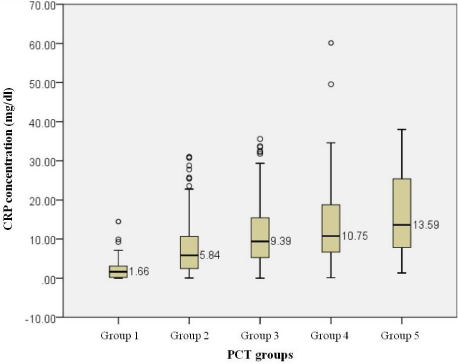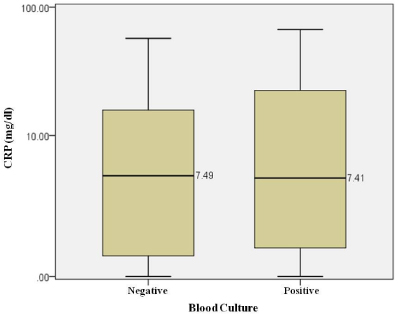J Dent Anesth Pain Med.
2015 Sep;15(3):135-140.
Diagnostic value of procalcitonin and CRP in critically ill patients admitted with suspected sepsis
- Affiliations
-
- 1Department of Laboratory Medicine, College of Medicine, Dankook University, Cheonan, Korea.
- 2Department of Anesthesiology and Pain Medicine, College of Medicine, Dankook University Hospital, Cheonan, Korea. jsmsmile81@naver.com
Abstract
- BACKGROUND
Identifying early markers of septic complications can aid in the diagnosis and therapeutic management of hospitalized patients. In this study, the utility of procalcitonin (PCT) vs. C-reactive protein (CRP) as early markers of sepsis was compared.
METHODS
A series of 2,697 consecutive blood samples was collected from hospitalized patients and serum PCT and CRP levels were measured. Patients were categorized by PCT level as follows: < 0.05 ng/ml, 0.05-0.49 ng/ml, 0.5-1.99 ng/ml, 2-9.99 ng/ml, and > 10 ng/ml. Diagnostic utility was analyzed by receiver operating characteristic (ROC) curves.
RESULTS
Mean CRP levels varied among the five PCT categories at 0.31 ± 2.87, 5.65 ± 6.26, 13.78 ± 8.01, 12.15 ± 10.16, and 17.77 ± 10.59, respectively (P < 0.05). PCT and CRP differed between positive and negative blood culture groups (PCT: 15.9 vs. 4.78 mg/dl; CRP: 11.5 ng/ml vs. 9.57 ng/ml; P < 0.05). The areas under the ROC curves (PCT, 95% confidence interval [CI]: 0.743, range: 0.698-0.789 at a threshold of 0.5 ng/ml; CRP, 95% CI: 0.540, range: 0.478-0.602 at a threshold of 8 mg/l) differed for PCT and CRP (P < 0.05).
CONCLUSIONS
Therefore, PCT is a reliable marker for sepsis diagnosis and is more relevant than CRP in patients with a positive blood culture. These findings can be useful for the treatment of critically ill sepsis patients.
Keyword
Figure
Reference
-
1. Rangel-Frausto MS, Pittet D, Costigan M, Hwang T, Davis CS, Wenzel RP. The natural history of the systemic inflammatory response syndrome (sirs). A prospective study. JAMA. 1995; 273:117–123.
Article2. Biffl WL, Moore EE, Moore FA, Peterson VM. Interleukin-6 in the injured patient. Marker of injury or mediator of inflammation. Ann Surg. 1996; 224:647–664.3. Mokart D, Capo C, Blache JL, Delpero JR, Houvenaeghel G, Martin C, et al. Early postoperative compensatory anti-inflammatory response syndrome is associated with septic complications after major surgical trauma in patients with cancer. Br J Surg. 2002; 89:1450–1456.
Article4. Ghillani PP, Motte P, Troalen F, Jullienne A, Gardet P, Le Chevalier T, et al. Identification and measurement of calcitonin precursors in serum of patients with malignant diseases. Cancer Res. 1989; 49:6845–6851.5. Maruna P, Nedelnikova K, Gurlich R. Physiology and genetics of procalcitonin. Physiol Res. 2000; 49:Suppl 1. S57–S61.6. Assicot M, Gendrel D, Carsin H, Raymond J, Guilbaud J, Bohuon C. High serum procalcitonin concentrations in patients with sepsis and infection. Lancet. 1993; 341:515–518.
Article7. Karzai W, Oberhoffer M, Meier-Hellmann A, Reinhart K. Procalcitonin--a new indicator of the systemic response to severe infections. Infection. 1997; 25:329–334.
Article8. Dandona P, Nix D, Wilson MF, Aljada A, Love J, Assicot M, et al. Procalcitonin increase after endotoxin injection in normal subjects. J Clin Endocrinol Metab. 1994; 79:1605–1608.
Article9. Hanley JA, McNeil BJ. A method of comparing the areas under receiver operating characteristic curves derived from the same cases. Radiology. 1983; 148:839–843.
Article10. Harbarth S, Holeckova K, Froidevaux C, Pittet D, Ricou B, Grau GE, et al. Diagnostic value of procalcitonin, interleukin-6, and interleukin-8 in critically ill patients admitted with suspected sepsis. Am J Respir Crit Care Med. 2001; 164:396–402.
Article11. Muller B, Becker KL, Schachinger H, Rickenbacher PR, Huber PR, Zimmerli W, et al. Calcitonin precursors are reliable markers of sepsis in a medical intensive care unit. Crit Care Med. 2000; 28:977–983.
Article12. Chalupa P, Beran O, Herwald H, Kasprikova N, Holub M. Evaluation of potential biomarkers for the discrimination of bacterial and viral infections. Infection. 2011; 39:411–417.
Article13. Hur M, Moon HW, Yun YM, Kim KH, Kim HS, Lee KM. [comparison of diagnostic utility between procalcitonin and c-reactive protein for the patients with blood culture-positive sepsis]. Korean J Lab Med. 2009; 29:529–535.
Article14. Povoa P, Almeida E, Moreira P, Fernandes A, Mealha R, Aragao A, et al. C-reactive protein as an indicator of sepsis. Intensive Care Med. 1998; 24:1052–1056.
Article15. Haupt W, Fritzsche H, Hohenberger W, Zirngibl H. Selective cytokine release induced by serum and separated plasma from septic patients. Eur J Surg. 1996; 162:769–776.16. Martin C, Boisson C, Haccoun M, Thomachot L, Mege JL. Patterns of cytokine evolution (tumor necrosis factor-alpha and interleukin-6) after septic shock, hemorrhagic shock, and severe trauma. Crit Care Med. 1997; 25:1813–1819.
Article17. Gattas DJ, Cook DJ. Procalcitonin as a diagnostic test for sepsis: Health technology assessment in the icu. J Crit Care. 2003; 18:52–58.
Article18. Claeys R, Vinken S, Spapen H, ver Elst K, Decochez K, Huyghens L, et al. Plasma procalcitonin and c-reactive protein in acute septic shock: Clinical and biological correlates. Crit Care Med. 2002; 30:757–762.
Article19. Oberhoffer M, Karzai W, Meier-Hellmann A, Bogel D, Fassbinder J, Reinhart K. Sensitivity and specificity of various markers of inflammation for the prediction of tumor necrosis factor-alpha and interleukin-6 in patients with sepsis. Crit Care Med. 1999; 27:1814–1818.
Article
- Full Text Links
- Actions
-
Cited
- CITED
-
- Close
- Share
- Similar articles
-
- Serum procalcitonin as a diagnostic marker of neonatal sepsis
- The value of presepsin, procalcitonin, and C-reactive protein in sepsis associated organ failure in the emergency department: a retrospective analysis according to the Sepsis-3 definition
- Comparison of Diagnostic Utility between Procalcitonin and C-Reactive Protein for the Patients with Blood Culture-Positive Sepsis
- Usefulness of Semi-quantitative Procalcitonin Assay in Critically Ill Patients with Bacterial Pneumonia
- Clinical utility of procalcitonin in severe odontogenic maxillofacial infection





